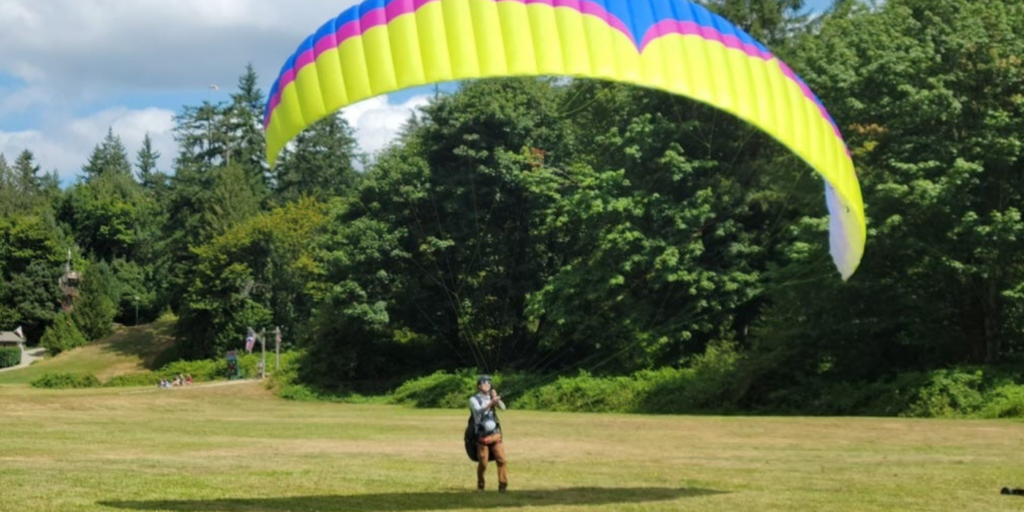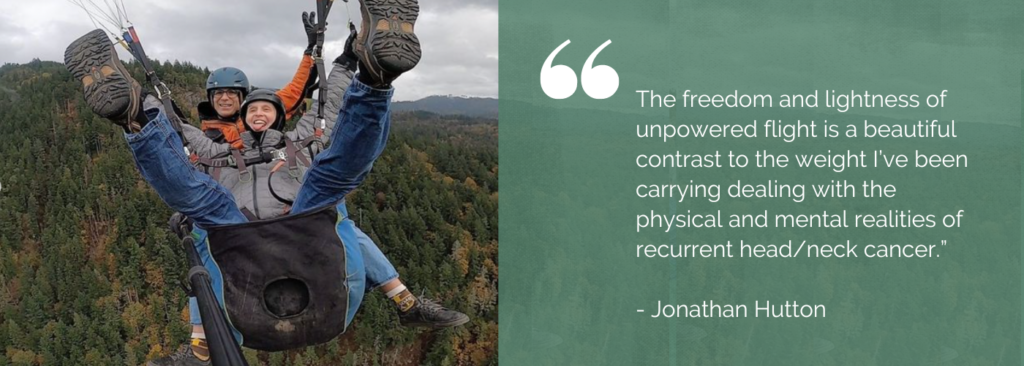by Jonathan Hutton
Send It Alumni, Jonathan Hutton, was awarded the Vy Nguyen Koller Grant towards a paragliding P2 pilot certification class in 2023.
Recurrence is a powerful motivator. More than 10 years ago, I started dreaming about paragliding, having discovered the sport after dabbling in skydiving. Rare and persistent head/neck cancer wasn’t the only thing that got in the way, but in early 2023, after another cycle of recurrence and surgery, I made a decision: no excuses, I’m going to learn how to fly this year. That summer, I went part-time at work, and enrolled in a training program. Here are seven things I learned along the way.

Paragliding is a solo sport and a community endeavor
After a dispiriting experience with my first tandem flight, I researched other areas beyond western WA to learn. Thankfully, an experienced pilot encouraged me to train at Tiger and connect with the local community. Between the folks at my school (NW Paragliding), the Tiger Mountain club, and the array of visiting pilots, I’ve come to understand that paragliding works best within the context of dedicated folks who share a passion for being in the sky.
Washington is the no. 1 state for paragliding
I hadn’t really considered this when I began my journey, but our state is arguably home to the most diverse array of flying sites in the country. While Tiger Mountain is the most recognizable and popular site, we also have a fun mix of mountain flying sites in the Cascades, scenic ridge soaring sites around the Puget Sound, and world class flat land flying in Eastern Washington. Increasingly, the best pilots in the world are moving to the Evergreen state.
There’s no substitute for expert instruction
Learning how to skillfully control a paraglider wing is significantly more difficult and counterintuitive than riding a bike or driving a car. Good instruction will help you build the most important skills so you can confidently progress over time. Choosing a qualified, USHPA certified instructor to learn from is the most important choice you’ll make at the beginning of your flying career.
Life revolves around the wind
Learning to fly will fundamentally alter your relationship to the weather. You’ll discover that wind indicators are all around and forecasts have new layers of meaning. As you become more familiar with reading and interpreting weather data, you learn that planning far in advance is a fool’s errand. Paragliding, and the related disciple parawaiting, require you to be flexible, patient, and open to last minute opportunities and changes.

Awareness is paramount
A paraglider is an aircraft, and piloting it safely requires a high degree of awareness and attention. Every time I fly, I want to be keenly aware of the site, my gear, other pilots, the wind and weather. In addition to pre-flight checks and situational awareness, I engage in self-reflection: Am I in the right headspace to fly? Do I understand the risks I’m taking and am I comfortable with them? I find that the pre-flight nerves usually subside once I’m airborne and settled into my harness; then a whole new form of focus takes over.
Kiting is fun, do it whenever you can
Tiger can intimidate newer pilots because the margin for error is narrower than a training hill on open landscape. This helps explain why we spent 10-15 hours ground handling for every hour in the sky. I’m grateful I learned this way, because I really love taking my wing out and playing in the wind. Finding new places to kite is an adventure in itself, and you’ll often meet curious strangers.
Flying will change you
Almost every pilot I’ve met on this journey has spoken about how paragliding has improved their lives. Purposefully refocusing your attention and perspective every time you fly is a gift. Whether soaring along a tree-lined ridge, launching into the sunset, or feeling the power of rising thermic air, these experiences remind us of our connection to the outdoors, and to the life and beauty around us.